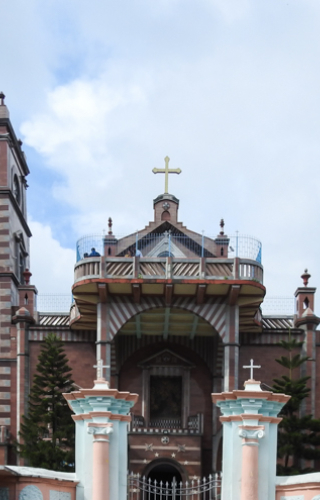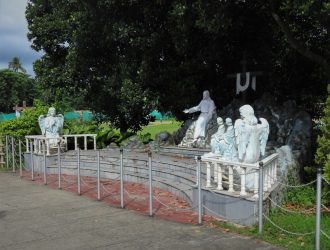The following churches situated in West Bengal bear testimony to the presence of the Portuguese in early modern Bengal (approximately, 1526–1858):
Bandel Church
Situated on the banks of river Hooghly in West Bengal’s Hooghly district, the Basilica of the Holy Rosary, or Bandel Church, is the oldest Catholic Church of Bengal. The church is said to have been constructed in 1599 by missionaries of the Augustinian order in the wake of Akbar’s farman of 1578–80 that allowed the Portuguese to settle in Hooghly. During Shah Jahan’s siege of Hooghly in 1632, the church was burnt down by the retreating Portuguese themselves. Soon after, however, it was rebuilt by John Gomes de Soto as the Portuguese got a new farman from Shah Jahan in 1633. Despite lack of contemporary corroborative evidence, the Augustinians claim that it was the ‘miracle of the elephants’—the refusal of the royal elephants to stomp over the Augustinian priests held captive post siege—that convinced Shah Jahan to grant the new farman.
There are numerous other stories of miracles associated with the church. The statue of Our Lady of Happy Voyage, now on the roof of the church, is believed to have been lost in the river during the siege, only to resurface on the shores when the church was rebuilt. The church roof also has a mast of a ship, which had miraculously escaped drowning during a storm because of the blessing of Our Lady of Happy Voyage. The church attracts thousands of visitors every year, particularly during Christmas.
Cathedral of the Most Holy Rosary
The Cathedral of the Most Holy Rosary, or Murgihata Church, the oldest Portuguese church of Kolkata, is on the Portuguese Church Street in the Barabazar market. It was built in 1690, when the Augustinians established a temporary cathedral at a site presented to them by Job Charnock. In 1700, the Augustinian friars replaced it with a brick cathedral at a short distance from the original. With the gradual expansion of the Portuguese population in eighteenth-century Calcutta, however, the present church was constructed in 1799, under the benefaction of a number of local Portuguese families and individuals.
Church of Our Lady of Dolours
Tucked in the bustling market of Sealdah is the church of Our Lady of Dolours, popularly known as the Baitakhana Church. With further dispersion of both the Portuguese and Catholic communities in colonial Calcutta, an Indian Christian lady, Grace Elizabeth, along with four Portuguese men, founded the church in 1809. Till the 1930s, this church belonged to the Portuguese padroado (literally, patronage) under the diocese of Mylapur.
Church of the Sacred Heart of Jesus
The church of the Sacred Heart of Jesus is located on Lenin Sarani, Dharmatala, Kolkata. It was founded in 1832 by Pascoa Baretto de Souza, grandmother of Sir Walter de Souza, who was consul general of Portugal in Calcutta.
In 1821, Ms de Souza’s son was tried by the court for shooting and injuring a person named Joseph Gonsalves while returning from the old Chowringhi Theatre. She vowed to build a church if her son got acquitted, leading to the foundation of the Sacred Heart of Jesus. Till 1844, the church was under the parish of the padroado.
















